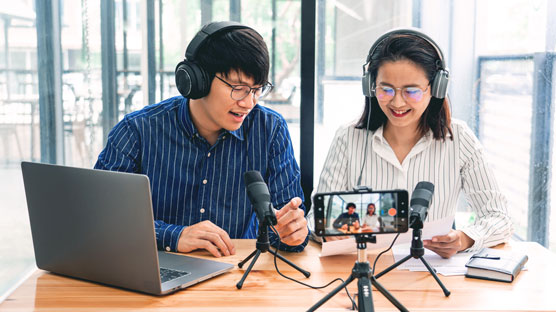
Ensure that your podcasts are well-received by adhering to technical standards for artwork and audio. Check out some of the podcasting directories where you want to have your podcasts listed. And if you’re doing a podcast interview, a little prep time can save a lot of embarrassment.
You can listen to podcasts in a variety of ways, such as telling your digital assistant (for example, Siri, Amazon Echo, or Google Home) to play the latest episode. Or you may choose a more traditional route and load an app on your desktop or mobile device to subscribe, so that the content is automatically downloaded when it becomes available.
For podcast producers, get to know the places to get your podcast published. The following links connect you to thousands of podcasts:
A major component of creating podcasts is the software used to record and edit your audio. Following are several suggestions for both PC and Mac:
Audacity (PC and Mac)
Logic Pro (Mac)
Audition (PC and Mac)
With your media recorded, edited, tagged, and ready for distribution, you need an online location to offer your podcast. The platform could be your own blog and plug-in combo, or an all-in-one podcasting solution.
When you’re ready to launch your podcast and as you continue to produce and post episodes, you’ll want to turn to a podcasting platform:
Interviews are your opportunity to engage with amazing and interesting individuals. You’re turning your show over to a guest who will have a platform to promote themselves, a charity, a special event, or something important to them. This unique opportunity introduces new voices to your podcast and expands the scope and reach of your show. When you open your show to guests, keep the following points in mind:
It’s easy to create an MP3 file; but with so many options available, what are the desired settings for compressed audio files? Too much compression and the audio will be altered, usually compressed to a point where the listening experience is unpleasant. Too little compression and your files will take longer to load and stream.
When making an MP3 file, you want to strike a happy medium between data compression and audio quality:
Keeping your podcast files organized helps both you and your listeners. Good naming practices make your files easy to sort. Applying consistent ID3 tags lets listeners know what’s they’re listening to.
Here are the ID3 tags, both essential and optional, explained in podcasting terms and why they matter:
After your show is edited and given ID3 tags, you’ll want to incorporate show art for the episode and then upload show art for your podcast where directories and podcast apps can access it easily. Depending on the nature of your podcast, you may want to change your show art season by season or episode by episode. When designing and posting show art, make certain your artwork meets the following criteria:
Tee Morris is an award-winning podcaster and the author of Twitch For Dummies and Discord For Dummies. Chuck Tomasi is a Developer Advocate who has created thousands of hours of content for work and fun.
Tee Morris is an award-winning podcaster and the author of Twitch For Dummies and Discord For Dummies. Chuck Tomasi is a Developer Advocate who has created thousands of hours of content for work and fun.
Tee Morris is an award-winning podcaster and the author of Twitch For Dummies and Discord For Dummies. Chuck Tomasi is a Developer Advocate who has created thousands of hours of content for work and fun.
Dummies has always stood for taking on complex concepts and making them easy to understand. Dummies helps everyone be more knowledgeable and confident in applying what they know. Whether it’s to pass that big test, qualify for that big promotion or even master that cooking technique; people who rely on dummies, rely on it to learn the critical skills and relevant information necessary for success.
Copyright @ 2000-2024 by John Wiley & Sons, Inc., or related companies. All rights reserved, including rights for text and data mining and training of artificial technologies or similar technologies.